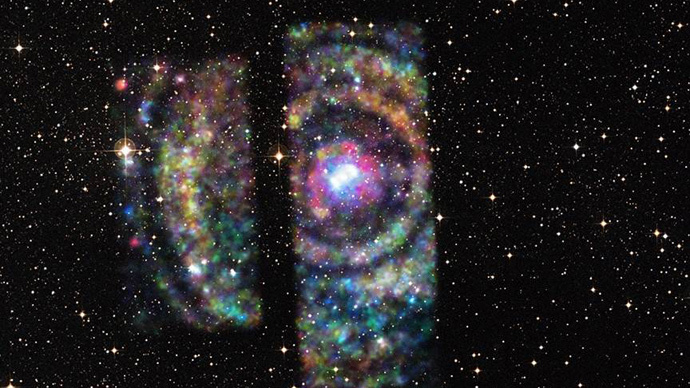Cosmic colors: Astronomers use 'interstellar rainbow' to map distance to star system

NASA has released an image of a breathtaking 'interstellar rainbow,' made possible by X-ray light echoes reflecting off clouds of dust. The beautiful rings have allowed astronomers to determine how far the double star system Circinus X-1 is from Earth.
The rings were the result of a burst of X-rays emitted by Circinus X-1 in late 2013, NASA said in a statement.
While the beautiful colors were certainly a feast for the eyes, they also served a vital purpose for astronomers, who used them to determine how far Circinus X-1 is from our planet.
Using the Chandra X-ray Observatory, the researchers determined that each individual ring was created by X-ray reflections off a different dust cloud.

They then compared the Chandra data to prior images of dust clouds collected by the Mopra radio telescope in Australia, and put their geometry skills to use.
“It’s really hard to get accurate distance measurements in astronomy and we only have a handful of methods,” said Sebastian Heinz of the University of Wisconsin in Madison, who led the study.“But just as bats use sonar to triangulate their location, we can use the X-rays from Circinus X-1 to figure out exactly where it is.”
The final result showed that Circinus X-1 is located about 30,700 light-years from Earth. The information settles the difference in results published in previous studies.
The findings also provided astronomers with other useful information. For instance, Circinus X-1 is much brighter in X-rays and other types of light than previously thought – meaning its brightness is more in line with a black hole than a neutron star.
READ MORE: 3-mile high ‘pyramid peak’ spotted on mysterious Ceres dwarf planet
"Circinus X-1 acts in some ways like a neutron star and in some like a black hole," said co-author Catherine Braiding of the University of New South Wales. "It's extremely unusual to find an object that has such a blend of these properties."
Circinus X-1 is a double star system located in the plane of our galaxy. It contains a neutron star, explained by NASA as “the dense remnant of a massive star pulverized in a supernova explosion.” The neutron star is in orbit with another massive star, and is shrouded by thick clouds of interstellar gas and dust. Circinus X-1 is also a source of a powerful jet of high-energy particles.
The double star system is believed to have become an X-ray source about 2,500 years ago, making it the youngest known 'X-ray binary.'
The NASA research was published in the Astrophysical Journal on Friday.












